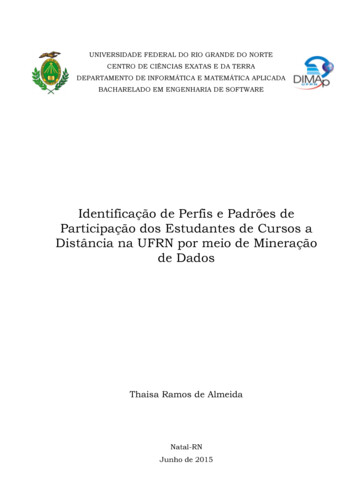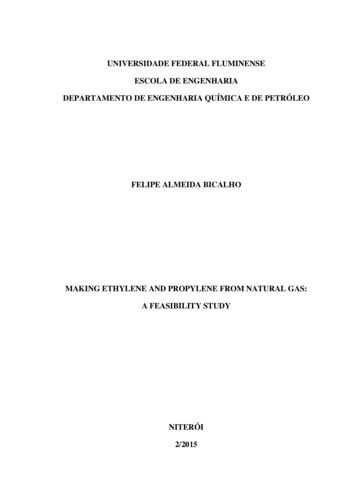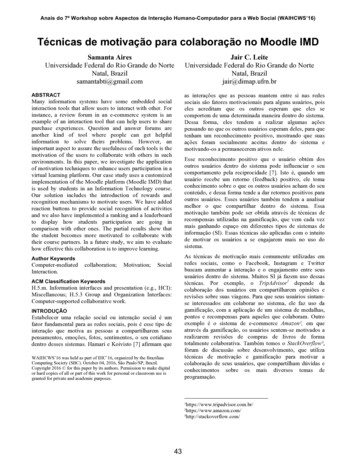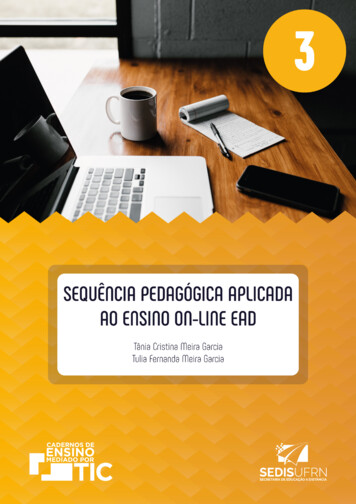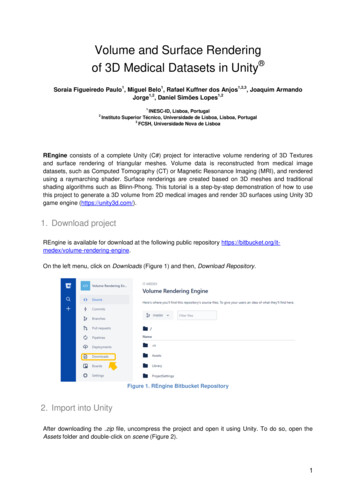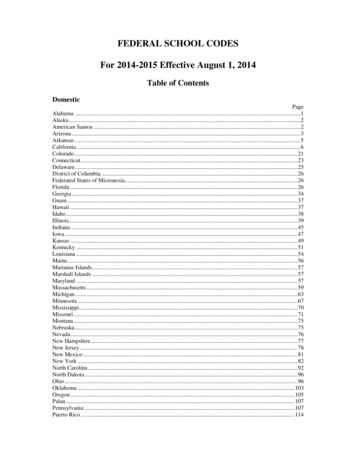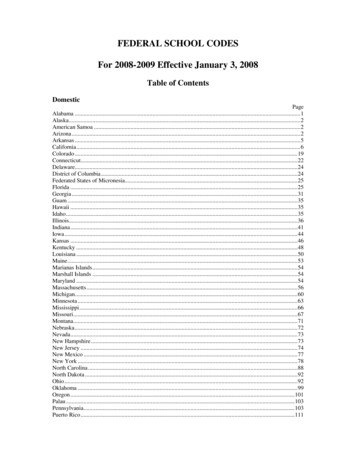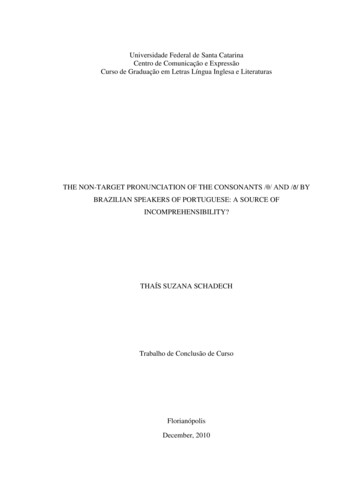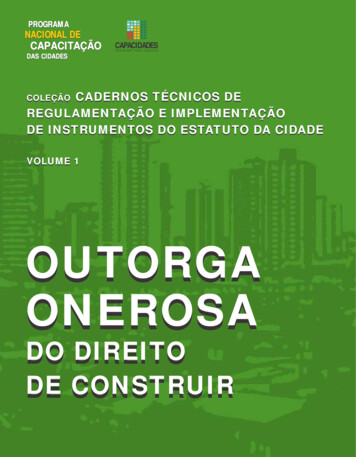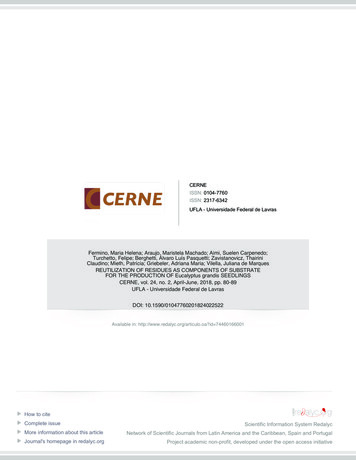
Transcription
CERNEISSN: 0104-7760ISSN: 2317-6342UFLA - Universidade Federal de LavrasFermino, Maria Helena; Araujo, Maristela Machado; Aimi, Suelen Carpenedo;Turchetto, Felipe; Berghetti, Álvaro Luís Pasquetti; Zavistanovicz, ThairiniClaudino; Mieth, Patrícia; Griebeler, Adriana Maria; Vilella, Juliana de MarquesREUTILIZATION OF RESIDUES AS COMPONENTS OF SUBSTRATEFOR THE PRODUCTION OF Eucalyptus grandis SEEDLINGSCERNE, vol. 24, no. 2, April-June, 2018, pp. 80-89UFLA - Universidade Federal de LavrasDOI: 10.1590/01047760201824022522Available in: http://www.redalyc.org/articulo.oa?id 74460166001How to citeComplete issueScientific Information System RedalycMore information about this articleNetwork of Scientific Journals from Latin America and the Caribbean, Spain and PortugalJournal's homepage in redalyc.orgProject academic non-profit, developed under the open access initiative
ISSN 0104-7760v.24 n.2 2018CERNEMaria Helena Fermino1, Maristela Machado Araujo2, Suelen Carpenedo Aimi2, FelipeTurchetto2, Álvaro Luís Pasquetti Berghetti2, Thairini Claudino Zavistanovicz2, PatríciaMieth2, Adriana Maria Griebeler2, Juliana de Marques Vilella3REUTILIZATION OF RESIDUES AS COMPONENTS OF SUBSTRATE FORTHE PRODUCTION OF Eucalyptus grandis SEEDLINGSFERMINO, M. H.; ARAUJO, M. M.; AIMI, S. C.; TURCHETTO, F.; BERGHETTI, A. L. P.; ZAVISTANOVICZ, T.C.; MIETH, P.; GRIEBELER, A. M.; VILELLA, J. M. V. Reutilization of residues as components of substrate for theproduction of Eucalyptus grandis seedlings. CERNE, v. 24, n. 2, p. 80-89, 2018.HIGHLIGHTSKeywords:Alternative substratesCarbonated rice huskHydrolyzed rice huskCrushed peach kernelForest nurseryThe Eucalyptus grandis seedlings, presented quality when grown on organic substrates.Organic compound mixed with carbonized and hydrolyzed rice husk and crushedpeach kernel.Carbonated rice husk (30%), hydrolyzed rice husk (20%) and crushed peachkernel (10%).These component can be used to improve the physical characteristics of the substrates.ABSTRACTHistoric:Received 11/02/2018Accepted 26/04/2018Correspondence:suaimi@gmail.com Increased production of agro-industrial waste is a global concern, requiring proper disposal.In this sense, they can represent alternative sources for substrate production, adding value tothe materials and reducing the cost of seedlings in the nursery. However, their proportionsin the mixture should be adequate for better use of water and nutrients, ensuring betterseedling quality. The objective of this study was to identify the potential of rice husk and peachkernel residue, as a secondary substrate component, for the production of Eucalyptus grandisseedlings. The carbonated (CRH), hydrolyzed (HRH) rice husk and crushed peach kernel(CPK) were added at 0, 10, 20 and 30% to an organic substrate. The results were submittedto analysis of variance and correlation analysis between the variables of the substrates and themorphological and physiological attributes. The results indicated that the HRH and CPK canadd value to the agro-industrial residue when mixed to the organic compound in proportionsof 20 and 10%, respectively, being adequate and compatible with the use of CRH in theproportion of up to 30%. Eucalyptus grandis seedlings, after 90 days of cultivation, presentedquality to be hardened and dispatched when grown on organic compound substrates with upto 30% CRH, 20% HRH and 10% CPK.Department of Diagnostic and Agricultural Research/Rio Grande do Sul - Porto Alegre, Rio Grande do Sul, BrazilFederal University of Santa Maria - Santa Maria, Rio Grande do Sul, Brazil3Department of Diagnostic and Agricultural Research/Rio Grande do Sul - Porto Alegre, Rio Grande do Sul, Brazil1DOI:10.1590/01047760201824022522280
REUTILIZATION OF RESIDUES AS COMPONENTS OF SUBSTRATE FOR THE PRODUCTION OF SEEDLINGSOF Eucalyptus grandisINTRODUCTIONSubstrate is the physical support for the rootgrowth of plants grown in containers, replacing thesoil in situ. Alternative components in the formationof substrate, to produce seedlings in nurseries, arecontinuously tested in order to replace or improveexisting ones. These components, when used in thesubstrate, should guarantee structural stability, allow gasexchange through the roots and provide water to theplants (Regan, 2014).In the cultivation in containers, regardless ofthe substrate used, there is limitation of space for rootexpansion, so it is necessary that the medium be able tomaintain a volume of water easily available to the plants,without compromising the oxygen concentration (Bunt,1961). Other characteristics considered essential for thesubstrate are: having good structure and consistency,not contracting or expanding excessively with moisturevariation, being free of toxic substances, inoculum ofdiseases, invasive plants, insects and excess salts, andbeing readily available (Kämpf, 2005).The quality of the substrate determines thebest use of factors, such as irrigation and nutrition,in addition to positively influencing the final product,making it possible to reduce or extend the time forseedling production. A substrate is generally the resultof the blending of two or more components (materials)formulated and engineered to provide the desired physicaland chemical properties. This is necessary because ofthe different species requirements, which conditions theuse of various mixtures and proportions of the availablecomponents. Among the main components used bythe industry are peat, vermiculite, perlite, decomposedtree bark, carbonated rice husk and coconut fiber. Inthis context, many agro-industrial residues can serve asan alternative material in the formation of substrates,allowing a more adequate disposal than conventional,adding value to materials and reducing the cost ofseedlings in the nursery.Rice (Oryza sativa) is a cereal of great consumptionworldwide. Bonaguro et al. (2017) highlighted that ricehusk is an agricultural by product that can be used inthe composition of substrates. In southern Brazil, forexample, it is estimated that approximately 20% ofthe total production of rice (around 1.460 thousandtons) correspond to the husk fraction, which due to itshigh calorific value and low cost is mainly used for thegeneration of energy (Slabão, 2014).In practice, after its use as a fuel for energyproduction, little use is made of the ash resulting from theFERMINO et al.CERNEprocess. According to Bezerra et al. (2011) when rice huskash is disposed in the environment, it can cause pollutionbecause contains significant amount of residual carbon,and is also harmful to health due to the high silica content,which can cause “silicosis”, a pulmonary infection.However, the rice husk can also be used as aconditioner (secondary component), which is used to alesser extent to improve the characteristics of the maincomponent of the substrate. This component has beentested in the production of several plants, especiallyflowers, vegetables and seedlings of tree species (Rota;Pauletti, 2008; Kratz; Wendling, 2016; Zavistanovicz etal., 2017; Watthier et al., 2017).The characteristic that explains this use is the highaeration space, about 20% or more when used in the“carbonated” form, which contributes to make blendslighter and with a higher air-water ratio. Carbonizationis an “incomplete burning” process, carried out in anartisan way, which allows the maintenance of the physicalstructure of the shell. On the other hand, an alternativeway of using the rice husk is through its hydrolysis, whosetreatment consists of immersing the bark in water, whichis frequently replaced.Among the agricultural activities that generatewaste, we also mention the cultivation of peach (Prunuspersica). In 2012, world production of peaches andnectarines was 21.083,151 tons, with China beingthe main producer, accounting for 57% of the total.Although Brazil is responsible for only 1.1% of the worldproduction, the culture has important insertion in smallfamily farms, destined for commercialization of freshfruit and the canning industry (Protas; Madail, 2003).As a residue of the peach canning industry, afterextraction of the pulp, the kernel is obtained. There are,however, other applications such as the extraction ofalmond oil for the production of cosmetics (Voronetsky,2011), which depends on the process of specializedindustrialization, unlike the use of crushed kernel inthe mixture of substrates. This component, similarly tothe carbonated or hydrolyzed rice husk, can be used toimprove the physical characteristics of the substrates,concomitantly with cost reduction.The genus Eucalyptus has been widely used inforest plantations due to its adaptation to differentclimatic conditions, soil and use of its products, thusreducing the pressure on native forests (Azevedo et al.,2017). For exotic forest species with strong commercialappeal, such as Eucalyptus, the production inputs, suchas containers and commercial substrates, are welldefined, but usually the latter are expensive and oftengeographically distant from production and, therefore,increasing the cost of the final product.81
REUTILIZATION OF RESIDUES AS COMPONENTS OF SUBSTRATE FOR THE PRODUCTION OF SEEDLINGSOF Eucalyptus grandisThus, additional studies are important to gainknowledge of the properties of new alternative materialsand their possible mixtures (Kratz et al., 2013; Kratz;Wendling, 2013). The Eucalyptus grandis W. Hill exMaiden. is a widely used species, including processedand solid wood and cellulose, consequently having itsforestry known. Thus, morphophysiological attributes ofthe seedlings can be used as indicative in the qualificationof inputs, as substrate.In this sense, this research seeks to answer thefollowing questions: a) are the hydrolyzed rice huskand the crushed peach kernel efficient components forseedling production of tree species? b) what are theappropriate proportion of carbonated, hydrolyzed ricehusk and crushed peach kernel that can be used in theformation of a substrate for Eucalyptus grandis seedlings?MATERIAL AND METHODSThe study was carried out at the Forestry andForest Nursery Laboratory of the Department of ForestSciences (29 43’13” S; 53 43’ 17” W) of the FederalUniversity of Santa Maria (UFSM) between October2015 and January 2016. According to the Köppen’sclassification, the region has subtropical Cfa climate, withrainfall all year round, average annual rainfall between1500 and 1600 mm and average annual temperature of19.2 ºC (Matzenauer et al., 2011).The commercial substrate Beifort S-10B (CS)was selected as the main component of the studybecause it is a stabilized organic substrate made fromcomponents derived from winemaking such as seedsand stalk, carbonated rice husk, peat and vermiculite.The components proposed as conditioners in this studywere the rice husk in two preparation forms: carbonated(CRH) and hydrolyzed or washed (HRH) and crushedpeach (CPK). To the mixtures of substrates, 8 g.L-1 ofcontrolled release fertilizer and formula NPK 15-09-12 Ca, Mg micronutrients (S, B, Cu, Mn, Fe and Zn)were added.The CRH was purchased from local producers.The HRH, alternative form proposed here, is based onthe treatment applied to the tung shell (Aleurites sp.)and to the pecan nut (Carya illinoensis) according toFermino et al. (2015) and was obtained using a watertank of 1000 L, in which 500 L of rice husk and 500 Lof water were placed. A sample was collected everytwo days in order to read the pH value and electricalconductivity. Subsequently, the water was completelydrained, and the box filled with water (approximately500 L). This procedure was repeated until the pH, theFERMINO et al.CERNEelectrical conductivity (EC) and the sedimentation of thehusk at the bottom of the vessel were stabilized, whenthe process was finished, after two weeks. The huskwas then dried outdoors under a covered area, and thenstored for use.The peach kernel from the Company Oderich S.A.was used after drying and grinding in a hammer mill. Tocompose the mixtures, the CRH, the HRH and the CPKwere added in proportions of 10, 20 and 30% (vol/vol) tothe Beifort S-10 commercial substrate (CS), totalizing 10treatments (Table 1). The experiment was carried out in acompletely randomized design, with four replications of 12seedlings, totalizing 48 seedlings per treatment.TABLE 1 Different types and proportions of componentstested as substrates for Eucalyptus grandis PKCS:CPKProportion 0Where: CS – Commercial Substrate; CRH – carbonated rice husk;HRH – hydrolyzed rice husk; CPK – crushed peach kernel.The analyzes of the physical and chemicalcharacteristics of the substrates were carried out in theLaboratory of Analysis of Substrates for Plants (LASPP),in the Department of Diagnosis and AgriculturalResearch (DDPA/SEAPI), in Porto Alegre, RS, Brazil. Thecommercial substrate and the mixtures with CRH, HRHand CPK, in all proportions used, were submitted to thedetermination of the wet (WD) and dry (DD) densities(Brazil, 2007; Brazil, 2008), total porosity (TP), aerationspace (AE), readily available water (RAW) and bufferingwater (BW) by means of water availability curves at thevoltages of 0, 10, 50 and 100 cm of water column heightcorresponding to voltages of 0, 10, 50 and 100 hPa (Brazil,2007; Fermino, 2014). As with the laboratory reading ofpH and EC values in substrate suspensions: deionizedwater in the ratio of 1: 5 (vol:vol) (Brasil, 2007).With the pure commercial substrate and themixtures (Table 1) the 50 cm³ polypropylene conical tubes,accommodated in the trays, were filled. Eucalyptus grandisseeds were purchased from the Institute for Researchand Forestry Studies, with two to three seeds being sowndirectly in the containers. The trays were then taken tothe greenhouse for emergencies and monitored alongwith routine practices of the nursery, maintaining control82
REUTILIZATION OF RESIDUES AS COMPONENTS OF SUBSTRATE FOR THE PRODUCTION OF SEEDLINGSOF Eucalyptus grandisof irrigation, temperature, relative humidity and possibleinfestations. When the seedlings presented two to threepairs of leaves they were submitted to thinning, leavingonly one seedling per container. At sixty days after sowing,alternation was performed, when the seedlings started tooccupy 50% of the trays. Irrigation was performed fourtimes a day with a flow rate of 8 mm.day-¹).The evaluation of the morphological and physiologicalvariables was performed at 90 days after sowing, when theseedlings of one of the treatments had a mean height of 20cm and stem diameter 2 mm, an appropriate conditionfor expedition (Wendling; Dutra, 2010).By the non-destructive method, the followingmorphological attributes were observed: height (H),with the aid of a ruler (cm); stem diameter (SD), witha digital caliper (mm); determination of relative levels ofchlorophyll a and b and the fluorescence of chlorophyll a.Relative levels of chlorophyll a and chlorophyll bwere obtained with a chlorophyll meter (ClorofiLOG,CF 1030, Falker Automação Agrícola, Brazil), in leaves ofthe middle third of the plant, which are also expressedin the Falker Chlorophyll Index (FCI). Chlorophyll afluorescence was performed with a JUNIOR-PAMmodulated pulse fluorometer (Walz, Germany) between8:00 and 10:00h. For the evaluations, the fourth expandedleave was kept in the dark, wrapped in aluminum foil, for30 minutes. It was then subjected to the determination ofthe initial fluorescence (Fo) and, subsequently, to a pulse ofsaturating light (10.000 μmol m-2.s-1) for 0.6s, determiningthe maximum fluorescence (Fm), the maximumphotochemical efficiency of PSII (Fv.(Fm)-1), calculated bythe variable fluorescence ratio (Fv Fm-Fo).In the evaluation of H and SD, eight seedlings wereused in each replication. For relative levels of chlorophylla and b three plants were used, and for chlorophyll afluorescence one plant was used in each replication.For the destructive method, three seedlings wereused in each replication to obtain the following variables:aerial dry mass (ADM), root dry mass (RDM), total drymass (TDM) and leaf area (LA).The aerial and root parts were separated, theroots were washed in water with the aid of sieves. Forthe quantification of LA, the leaves were distributedon A4 white paper, after being pressed by transparentglass and photographed with a SONY digital camera(model DSC-T100), fixed at 18 cm height and 1.4 zoom.Afterwards, the images were processed with the aid ofImage J. analysis software.To obtain the dry mass, the aerial and root partswere submitted to oven drying with air circulation at 65 Cuntil constant weight. Afterwards, they were weighed inFERMINO et al.CERNEa precision digital scale (0.001 g) to obtain ADM, RDMand TDM.In the statistical analysis, the assumptions ofnormality of residues and homogeneity of varianceswere verified, using the Shapiro-Wilk and Bartlett tests,respectively (at 5% probability). When these assumptionswere not met, the variables were transformed by the BoxCox method. Subsequently, the data were submitted toanalysis of variance and polynomial regression analysis at5% probability of error. For the analyzes, the statisticalprogram SISVAR (Ferreira, 2014) was used. In addition, thePearson correlation (r) was performed at a 5% significancelevel between the substrate and seedling variables.RESULTSAnalysis of the substrate mixturesThe dry density (DD), total porosity (TP),aeration space (AS), readily available water (RAW) andbuffering water (BW), as well as the chemical variablespH and electrical conductivity (EC) are different(p 0.05), depending on the component and proportionused (Figure 1, 2 and 3). The commercial substrate (T1)presented DD of 267 kg.m-³, whereas for the mixtureswith CRH (carbonated rice husk) and HRH (hydrolyzedrice husk) this variable was moderately reduced as therespective percentages in the composition increased(Figure 1A). Conversely, for the mixtures with CPK(crushed peach kernel), the DD grew linearly as theproportion of this conditioner in the blend increased.The total porosity of the commercial substrate wasof 0.77 m³.m-³, while the mixtures with CRH increasedlinearly to the TP (T4 0.8 m³.m-³) with the addition ofthis conditioner (Figure 1B). The mixtures with HRH didnot significantly change the value of the TP (T7 0.78m³.m-³). The mixtures with CPK decreased the TP as thiscomponent increased (T10 0.71 m³.m-³).The commercial substrate (T1) presented AS of0.13 m³.m-³ (Figure 2A). Here was a linear increase ofthe AS in all the mixtures, that is, of the macroporositywith the increase of the conditioners. The values of thisvariable for the CRH and the CPK were equivalent,that is, they grew with the increase in percentages andpresented similar values (T4 and T10 0.22 m³.m-³).The HRH presented higher AS values of 0.31 m³.m-³when 30% was used in the mixture (T7).The value of RAW of T1 was 0.23 m³.m-³ (Figure2B), whereas in the mixtures with CRH these values werehigher than all the treatments and varied little with theincrease of the CRH content in the mixtures (T4 0.2483
REUTILIZATION OF RESIDUES AS COMPONENTS OF SUBSTRATE FOR THE PRODUCTION OF SEEDLINGSOF Eucalyptus grandisa.b.CERNEa.b.FIGURE 1 a. Dry Density (kg.m-³); b. Total Porosity (m³.m-³)commercial substrate mixtures and doses (0, 10, 20and 30%) of conditioners (CRH), hydrolyzed ricehusk (HRH) and crushed peach kernel (CPK), SantaMaria, RS, Brazil.m³.m-³). The values for The mixtures with HRH and CPKreduced as the percentages of these components wereincreased (T7 and T10 0.17 0.17 m³.m-³), except for themixture of 10% of HRH, which was similar to the CRH.The buffering water (BW) showed a trend ofreduction regardless of the conditioner used (Figure2C). The values of the CRH were higher and with smalleramplitude than the ones of HRH and CPK, while thevalues of HRH were higher than those of CPK, at 10%and 20%.The value of the EC of the commercial substrate(T1 0.5135 dS m-¹) was higher than all mixtures, exceptfor the use of 10% of HRH (T5 0.538 dS m-¹). As theproportion of all conditioners increased, the values of theEC decreased (Figure 3A).The pH value of the CRH mixtures was higher incomparison to all the others (Figure 3B). The mixtureswith HRH and CPK presented lower values, even lowerthan the commercial substrate (T1 5.68). However,the difference between the lowest (T5 5.41) and thehighest (T2 5.95) was very small.FERMINO et al.c.FIGURE 2 a. Aeration Space (m³.m-³); c. Readily AvailableWater (m³.m-³); c. Buffering Water (m³.m-³) fromthe mixtures of the commercial substrate and doses(0,10, 20 and 30%) of conditioners [carbonated ricehusk (CRH), hydrolyzed rice husk (HRH) and crushedpeach kernel (CPK)], Santa Maria, RS, Brazil.Production of Eucalyptus grandis seedlingsFor height (H), stem diameter (SD) and root drymass (RDM), there was no significant statistical difference(p 0.05) at 90 days of cultivation. The height of the E.grandis seedlings reached a mean value of 29 cm, while theaverage of the stem diameter was 2.1 mm and that of theRDM reached 0.56 g. For these three variables the CPKpresented the lowest values, while the CRH presentedthe highest.84
REUTILIZATION OF RESIDUES AS COMPONENTS OF SUBSTRATE FOR THE PRODUCTION OF SEEDLINGSOF Eucalyptus grandisCERNEa.a.b.b.FIGURE 3 a. Electrical conductivity (dS.m-¹); b. pH value of thecommercial substrate mixtures and doses (0, 10, 20and 30 %) of conditioners [carbonated Rice husk(CRH), hydrolyzed rice husk (HRH) e crushed peachkernel (CPK)], Santa Maria, RS, Brazil.The aerial dry mass (ADM), total dry mass (TDM),leaf area (LA), relative chlorophyll a (Chl a), chlorophyllb (Chl b), and maximum quantum yield of photosystemII (Fv.(Fm)-1) were influenced by the substrate (p 0.05).The E. grandis seedlings presented higher ADM,TDM and LA (Figure 4) when the conditioner was theCRH or the HRH, up to 20%, when compared with thecommercial substrate (T1 1.16 g, 1.67 g and 13.10 cm2,respectively). For the attributes, the less favorable resultswere found in seedlings produced with substrate containingthe CPK (T9 0.73 g, 1.14 g and T8 9.81 cm2, respectively).The FCI (Falker Chlorophyll Index) for Chl a andChl b of the E. grandis seedlings presented the sametrend (Figure 5), respectively, with 36.01 and 10.23 aswas observed in the commercial substrate (T1), similarto those obtained with up to 20% of the CRH (T3 36.04 and 10.23 FCI). For the CPK and the HRH, thevalues decreased significantly after the addition of 10%,but reversed the trend of the curve with the addition of30% of the components (Figure 5).FERMINO et al.c.FIGURE 4 a. Electrical conductivity (dS.m-¹); b. pH value ofthe commercial substrate mixtures and doses (0,10, 20 and 30 %) of conditioners [carbonated Ricehusk (CRH), hydrolyzed rice husk (HRH) e crushedpeach kernel (CPK)], Santa Maria, RS, Brazil.The maximum quantum yield of photosystem II (Fv.(F ) ) demonstrated a superior result when the conditionermwas HRH, in the proportion of 20% (T6 0.81), but seedlingsproduced with up to 30% of CRH and up to 10% of CPKpresented adequate quantum yield of about 0.75 (Figure 6).The DD correlated negatively with the TP, a resultthat confirms those observed in Figures 1A and 1B, as theDD increases, especially with the CPK, the TP decreases(Table 2). The same happens with H, SD, RDM, TDM,-185
REUTILIZATION OF RESIDUES AS COMPONENTS OF SUBSTRATE FOR THE PRODUCTION OF SEEDLINGSOF Eucalyptus grandisCERNEFIGURE 6 Maximum quantum yield of photosystem II (Fv.(Fm)-1) of Eucalyptus grandis due to the mixtures ofcommercial substrate and doses (0, 10, 20 and 30%) of conditioners [carbonated rice husk (CRH),hydrolyzed rice husk (HRH) e crushed peachkernel (CPK)], Santa Maria, RS, Brazil.a.LA and Fv.(Fm)-1 demonstrating that the addition of CPKin the mixture increases the DD and reduces the value ofthese morphophysiological attributes. The TP correlatedpositively with H and Fv.(Fm)-1, so that the increase in theTP also increases in H and in the Fv.(Fm)-1 ratio. The TPalso presented a positive correlation with the RAW and thisone with the BW and H, SD and MSPA. The BW correlatedpositively with H, SD, ADM, TDM, LA and Fv.(Fm)-1.b.FIGURE 5 a. Relative Chlorophyll a content (Chla); b. RelativeChlorophyll b content (Chlb) of Eucalyptus grandisdue to the mixtures of commercial substrateand doses (0, 10, 20 and 30 %) of conditionersconditioners [carbonated rice husk (CRH),hydrolyzed rice husk (HRH) e crushed peachkernel (CPK)], Santa Maria, RS, Brazil.DISCUSSIONWe found that the CPK (peach kernel) and CA(hydrolyzed rice husk) are potential components forthe conditioning of substrates, similarly to the CRHTABLE 2 Correlation coefficients among the variables: dry density (DD), total porosity (TP), aeration space (AE), readily availablewater (RAW) and buffer water (BW), mixtures of commercial substrate and doses (0,10, 20 e 30 %) of conditioners[carbonated rice husk (CRH), hydrolyzed rice husk (HRH) e crushed peach kernel (CPK)], and the variables height(H), stem diameter (SD), aerial dry mass (ADM), root dry mass (RDM), total dry mass (TDM), leaf aera (LA), Falkerchlorophyll index (FCI) clorophyll a and b and maximum photochemical efficiency of PSII (Fv/Fm) of Eucalyptus grandisat 90 days after sowing, Santa Maria, RS.DDTPAERAWBWHSDADMRDMTDMLAChl aChl MRDMTDMLAChl aChl bFv/Fm-0.62ns 0.57ns-0.69* 0.66*-0.74* 0.62ns-0.56ns 0.41ns-0.68* 0.49ns-0.64* 0.46ns-0.69* 0.52ns-0.09ns -0.01ns-0.25ns 0.14ns-0.83** 1-0.06ns110.87**10.79** 0.74*0.90** 0.97**0.92** 0.91**0.16ns 0.44ns0.32ns 0.55ns0.78** 0.55ns10.87**10.86** 0.95**1-0.10ns 0.29ns 0.24ns0.07ns 0.42ns 0.38ns0.76* 0.66* 0.75*ns non-significant; * p 0.05; ** p 0.01.FERMINO et al.86
REUTILIZATION OF RESIDUES AS COMPONENTS OF SUBSTRATE FOR THE PRODUCTION OF SEEDLINGSOF Eucalyptus grandis(carbonated rice husk), but they should be used indifferent proportions. This can happen because aspectsof the particles such as shape and size are different,consequently interfering in the arrangement of eachmixture and in the porosity. This condition influencedthe physical characteristics of the substrates, as it waspossible to observe for the CPK, in which, the increase inthe mixtures was directly related to the DD (dry density),and inversely related to the TP (total porosity), conditionopposite to the CRH and HRH (Figure 1).The CRH is a component recognized forincreasing the AE, in relation to the materials availablein the market (Vieira; Pauletto, 2009; Faria et al., 2013;Kratz et al., 2013; Watthier et al., 2017), and when addedup to 30%, showed the same behavior as CPK (Figure2B), which highlights the peach kernel residue as potentialto increase the aeration space, conditioning the drainage.On the other hand, when DD is observed, the use of thehighest proportions of CPK are not suitable for containersconventionally used for Eucalyptus seedlings ( 12 cmheight), but for containers with a height between 20 and30 cm (Kämpf, 2005). In addition, with an increase in theproportion of CPK, there was a significant reduction ofthe TP ( 0.8 m³.m-³), limiting its use.The values of AS of the HRH are rarely foundin materials used as components of substrates, whichalso makes it a material with high potential of use, withemphasis on the production of seedlings by cuttings thatrequire more aeration space for rooting. This, combinedwith a reduction in the value of RAW (readily availablewater), when compared to CRH, indicates the need toincrease the frequency of irrigation due to the reductionof water availability, even in the face of a 20% increasein HRH (Figure 2B). This result may be useful for specieswith low water requirement due to adaptability toenvironmental conditions, such as Parapiptadenia rigida(Dutra et al., 2016).The values of BW (buffer water) between 0.02and 0.05 m³.m-³, are usually found for substrates inlaboratory analyzes¹, being considered by Azevedo et al.(2014) as a content of little expressiveness to plants.As expected by the characteristics of thesecondary components (CPK, HRH and CRH) EC valuesdecreased with the addition of higher proportions ofthese materials (Figure 3A). However, the pH increasedwith the addition of CRH, a predictable fact due to thehigh original value of CRH, generally close to 8.0. On theother hand, for CPK and HRH there was a decrease inpH up to 20% of addition of the materials, subsequentlyincreasing up to 30%. In spite of these variations, forFERMINO et al.CERNEmost mixtures EC and pH values may be consideredsuitable (EC 0.48 to 0.54 dS m-¹ and pH 5.5 to 5.8)for plant growth, with a maximum limit of 0.75 dS m-¹for EC and a range between 5.5 and 6.3 for pH (Regan,2014). However, the need for greater control whenusing 20% of HRH should be emphasized, since it canreach pH of 5.4, requiring correction (Figure 3B).Most of the mixtures favored the growth ofEucalyptus grandis, providing planting seedlings after 90days of cultivation. The CRH, in all proportions used,confirms other studies (Figuêredo et al., 2014; Kratz;Wendling, 2016). In the case of HRH, which is obtainedfrom a less polluting technique and with less social impact,adequate growth up to 20% in the mixture was found,similarly to the results obtained with the CRH. Thiscan be proved by the morphological attributes ADM,TDM and LA (Figure 4) and maximum quantum yield ofphotosystem II (Fv.(Fm)-1), since H, SD and RDM did notmake it possible to distinguish superior quality betweentreatments. On the other hand, it is worth noting that inthis study, the mean values of H and SD
classification, the region has subtropical Cfa climate, with rainfall all year round, average annual rainfall between 1500 and 1600 mm and average annual temperature of 19.2 ºC (Matzenauer et al., 2011). The commercial substrate Beifort S-10B (CS) was selected as the main component of the study
